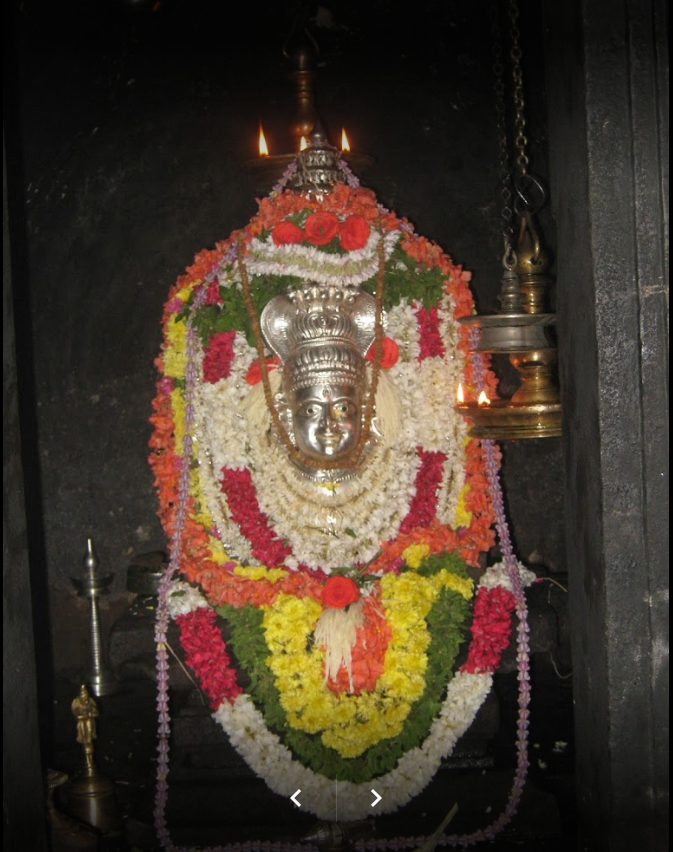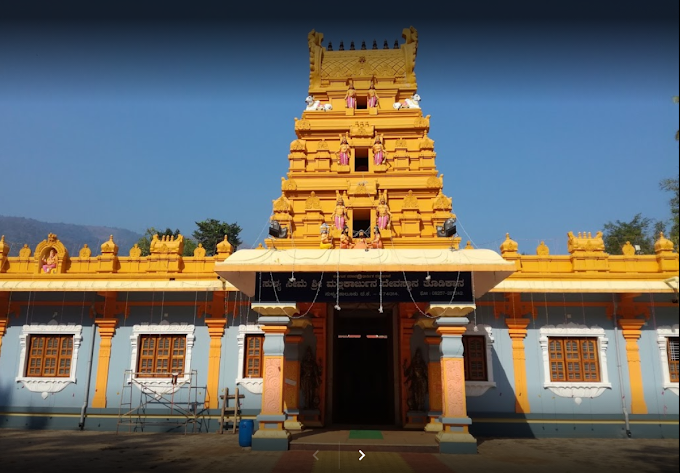About
Kodlamane is a Tirth Khestra and Hindu pilgrimage site where Kodlamane Shree Vishnumurthy Temple is located. It is located in a hill forest. As per local legend the temple was discovered in the middle of dense forest centuries back. It is in Honnavar Talu
Spiritual Importance[edit]
Devanagari
यश्य स्मरण मात्रेन जन्म सन्सार भन्दनात्
विमुछते नमह तस्मै विष्नवे प्रभु विष्नवे
Yashya SmaraN maatren janm sansaar bhandanaat Vimuchhate namah tasmai viShnave prabhu viSHnave
During Satya Yuga (Sanskrit: सत्य युग), sages wanted to get their rebirth during Kali Yuga (Sanskrit: कली युग). Reason behind Sages had to perform long rigorous tapas to achieve moksha in Satya Yuga and sages were aware that moksha can be achieved in Kali Yuga only by meditating on Lord Vishnu.
Hence only Shree Maha Vishnu is known as Mokshadata मोक्शदाता श्री महाविष्णु.
One should be lucky to visit this temple at least once in lifetime, where Shree Mahavishnu resides himself who is the supreme with other devi-devatas.
Vedic Architecture
The temple is very beautiful which will take the pilgrims to the world of devotion. The Temple is designed and built on Vedic Hindu temple architecture. It has Garbhagriha, Antarala, Sandya Mandap, Maha Mandap, Pradakshina, Subsidiary Shrines, Bali Peetha, Garuda Stambha. The Garbhagriha is Sanctum sanctorum facing east where presiding deity Lord Vishnumurthy is residing along with other deities which are Lord Maheshwar (in the form of Shiva Linga), Lord Ganapati, Devi Durga. Sacred Saligram are also there which is which is symbol of God Vishnu. Utsav Murthy (Lord Vishnumurthy processional deity) is also residing at Garbhagriha which will be taken out on special occasions. occasions. They all are in Mandan, hence called Devata worshiped in Mandan. Lord Vishnumurthy is in standing posture with four hands holding Shanka, Chakra, Gada, Padma. The murthy also called Vigraha or Idol is carved in sacred black natural stone. Murthy height is about 3.5 ft from peetha to top of crown and peetha is 1.5 ft height. The Garbhagriha is square shape built with natural stones and Shikhara or Gopura or Vimana above sanctum sanctorum is octagon which is also built by natural stones. The roof of Shikhara is covered by Copper sheets ( which passes higher energy). Kalash is fixed on top of copper roof called Shikhara Kalash which is gold plated on copper. After the Antarala in Sandya Mandap there is Kuladevata Stan who is Shree Kamakshi Devi of Shiroda, a Goddess of Shakti. The whole set up is called Garbhagudi. The roof of Garbhagudi is coved with copper sheets. The walls and pillars of Garbhagudi are beautifully painted in Kaavi art , depicting Dashavatars of Mahavishnu, Ganapati, Saraswati, Hanumatha, Garuda, Temple chariot, pallaki, flowers etc.
Whole Garbhagudi is elevated around 3 feet above the pradakshina level. On either side of first door of Garbhagudi there is Jaya-Vijaya beautifully carved in natural black stone. Garbhagudi has 3 doors facing east looking at Holy River of Sharavati which flows within 500 m. Garbhagudi has 3 doors. Its door frame carved from natural stone. Beautifully carved wooden doors fixed over the 3 stone door frames, and are in descending order height width, which is very well planned architecture. Wood used is Shivani for door frame and jack fruit for door leaf. First door of garbhagudi(door of sandya mandap) has Shree Yoga Narasimha on top and Shree Hanuman on left and Shree garuda on right side on door frame. The whole door is matt painted in dark chocolate colour, thus gives feel of a stone or metal. Second door which is for Antarala is covered with pure silver and Shree Astha Lakshi on top. Third door which is door of garbhagriha is also covered with pure silver with Shree Lakshmi-Narayan to top. Artists have shown their best in wooden and silver carving. Oil lamps are placed both sides of garbhagriha door which is very appealing, gives feel of ancient temple.
Pilgrims are not allowed to enter garbhagudi.
The pradakshina (going round of garbhagudi clockwise) will lead to other shrines which are Shree Mukhyaprana first on right side facing north and Shree Yakshi or Yakshini Shrine (where sanyasi peetha is presided) on left side facing east. They are called Parivar Devatas. Then it will lead to Yagna Mandap (Yagna Shala). The main temple building door is facing east.
In second prakara (also called as Prakaram to east(front side) there are other small shrines of Shree Jataka, Shree Nag and Shree Chawndi, Garuda Stamba, Bali Peetha and Tulasi, to south (left side) is Vishnu Tirth, to west (behind)is paak shala (temple kitchen) where prasad or naivedya is prepared, to north (right side) is function hall. Pilgrims who will enter temple main gate from north side will come to second prakara which will lead to temple main door. Before entering the main gate, there is Shree Kshetra pala Peetha on hill forest, who is there to safeguard the whole temple premise and Kodlamane.
Festivals of Temple
Temple celebrates following festivals, pooja, yagna throughout the year, which are celebrated with great splendor and joy.
Starting from Ugadi they are Shree Ramanavami, Shree Hanuma Jayanti, Sudarshan Hawan or yagna, Tulasi Archan only during adheek mas(leap year), Ananta Chaturdashi, Navarathi Pooja with Bhajans (9 day festival), Vanabhojan, Vardanti of Shree Vishumurthy, Shree Mukhyaprana and Shree Yakshi, Ganahoma.
Finally the major festival of the temple is Shree Vishnumurthy Rathostava ( Chariot Festival ) which is celebrated every year. This is 5 days starting from Garuda Stapana, Pushpa Rathostava, Brahma Rathostava, Avabratha Snan in morning and Teppostava (float festival) in night, Bhajan Mangal. Shree Vishnumurthy's utsav murthy (processional deity) is taken for procession in pallaki, Ratha and Teppa. Devotees and pilgrims will be flooded in temple during this event and specially on Bhrahma Rathostava.
Devanagari
रथस्य केशवम द्रस्त्वा पुनर्जन्म न विद्यथे
English
Rathasya Keshavam drastwa Punarjanm na Vidyathe
Meaning- one who will take Darshan of (visit) Lord Vishnu( Keshav) on Ratha will get Moksh, - liberation from cycle of death and rebirth.
Temple Puja
Devanagari
विष्णु अलंकार प्र्यिय
शिवा बिल्व प्र्यिय
गणेश दूर्वा प्र्यिय
देवी कुम्कुमार्चना प्र्यिये
Meaning in orderwise
Vishnu is fond of decoration (referred to idol decoration by tulsi, sacred flowers, precious ornaments etc.)
Shiva is fond of bilwa (or bael or Aegle marmelos) hence bilva is offered for Shiva lingam.
Ganesha is fond of durva (a type of grass). hence durva is offered for Ganapati puja.
Devi (Hindu Goddess) is fond of kumkuma ( special type of red powder used for Hindu religion) offered on her idol with chanting vedic mantra
Temple nitya Puja (daily rituals) has 3 sessions performed by temple archaka or pujari with chanting vedic mantras. Generally Rigveda based.
Prathahakal puja (Sanskrit प्रातहकाल पुजा)
Nirmalya Visarjana (Sanskrit निर्मल्य विसर्जन ), Naivedhya (Sanskrit नैवेद्य), Aarti
Mahapuja (Sanskrit महापूजा) -
3 types Abhisheka (Sanskrit अभिषेक) performed.
kherabhisheka (Sanskrit क्शीराबिषेक )- Milk bathing for the Murthy Panchamrita abhisheka - bathing with five sacred liquids which are milk, ghee, honey, liquid jaggery, curd. (sugar is not used), shuddhodaka snaana - Bathing idol with pure water bought from sacred well.
Then Alankara - decorating the murthy with flowers, tulsi, ornaments and cloth.
Offering Maha Naivedhya Dhoop and Maha Mangalarathi. In between many rituals are done by the priest.
Ratropuja (Sanskrit रात्रोपूजा)
Naivedhya, Dhoop and Aarti.
During daily puja archaka plays ghanti (or ghanta a ritual bell) during worship and aarti. Devotees ring temple bells during aarti.
On special occasions conch (Shankha), jaganthi (music instrument used for puja) and Panchavadya (or panchavadyam 5 musical instruments) are played. Panchvadhya is referred to Samaveda.
Only hereditary archaka are currently have the right to offer Nitya puja to Lord Vishnumurthy and parivaar devatas. One special occasions archakas from other families also assist him in temple puja.















